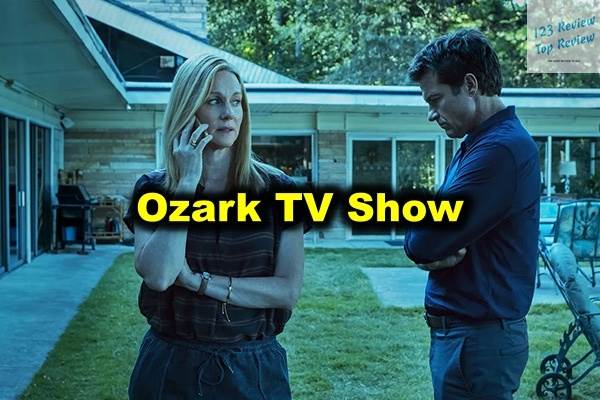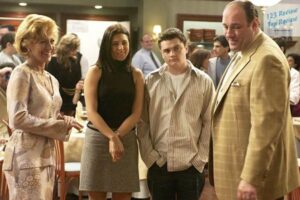With its intense storyline, complex characters, and gripping tension, “Ozark TV Show” offers a captivating exploration of morality, power, and the lengths one will go to protect their family. The Byrdes’ descent into the criminal underworld is marked by moral ambiguity, betrayal, and escalating stakes, making “Ozark” a must-watch series for fans of high-stakes drama and suspense.
Overview of Ozark
Plot Summary
“Ozark,” a critically acclaimed crime drama series, made its debut on Netflix in 2017, captivating audiences with its intense narrative and morally complex characters. Created by Bill Dubuque and Mark Williams, the series revolves around the seemingly ordinary Byrde family, who are suddenly thrust into the perilous world of organized crime. The story begins with Marty Byrde, a Chicago-based financial planner, who is forced to relocate his family to the rural Ozarks in Missouri after a money-laundering scheme he was involved in goes awry. Faced with the threat of death at the hands of a Mexican drug cartel, Marty proposes a bold plan to launder a massive amount of money in the Ozarks, a region he believes will be under less scrutiny.

As the Byrdes settle into their new life, they quickly realize that the Ozarks are far from the quiet, safe haven they had hoped for. The family becomes entangled with dangerous locals, including criminals, corrupt officials, and rival factions. Marty’s wife, Wendy, a former political strategist, gradually takes on a more significant role in their criminal enterprise, while their children, Charlotte and Jonah, are pulled deeper into the family’s illicit activities. Throughout the series, the Byrdes must navigate a treacherous landscape filled with deception, violence, and betrayal, all while trying to maintain a semblance of normalcy.
Main Characters
“Ozark” features a richly developed cast of characters, each of whom brings their own complexities and motivations to the story:
- Marty Byrde: Portrayed by Jason Bateman, Marty is the show’s central figure. A financial genius with a calm and calculating demeanor, Marty’s quick thinking and resourcefulness are both his greatest assets and his greatest burdens. He is a man constantly on the brink, trying to keep his family safe while managing the demands of a ruthless cartel.
- Wendy Byrde: Played by Laura Linney, Wendy undergoes one of the most dramatic transformations in the series. Initially presented as a supportive wife, Wendy evolves into a formidable strategist in her own right. Her political background and sharp instincts make her a crucial player in the Byrdes’ operations, often pushing her to make morally ambiguous decisions.
- Ruth Langmore: Julia Garner’s portrayal of Ruth Langmore has earned widespread acclaim. Ruth is a young woman from a local criminal family, whose rough upbringing has made her both tough and fiercely independent. Despite her initial antagonism toward the Byrdes, Ruth becomes one of their most loyal and capable allies, though her loyalty is constantly tested.
- Charlotte and Jonah Byrde: The Byrde children, Charlotte (Sofia Hublitz) and Jonah (Skylar Gaertner), are thrust into a world of crime at a young age. Their character arcs explore the loss of innocence and the psychological toll of growing up in an environment where criminal activity becomes the norm.
- Supporting Characters: The series also features a range of supporting characters who significantly impact the narrative. These include Darlene Snell, a local drug queenpin with a fierce sense of independence; Agent Roy Petty, an FBI agent obsessed with bringing the Byrdes to justice; and Helen Pierce, the cartel’s ruthless lawyer who becomes a formidable adversary.
The Byrde Family Dynamics
At the heart of “Ozark” lies the complex and evolving dynamics of the Byrde family. Initially, Marty and Wendy attempt to shield their children from the full extent of their criminal activities, but as the series progresses, the entire family becomes complicit in their dark dealings. The show masterfully portrays the strain that these circumstances place on their relationships. Marty and Wendy’s marriage, once based on mutual respect and shared goals, becomes a battleground of conflicting interests and power struggles. The children, Charlotte and Jonah, each cope in their own ways—Charlotte initially rebels against the family’s new life, while Jonah becomes increasingly involved in the business, displaying a disturbing aptitude for the criminal world.
The family’s dynamics are further complicated by the external pressures they face. As Marty and Wendy delve deeper into the criminal underworld, they must constantly weigh the safety of their family against the demands of the cartel. This tension drives much of the show’s drama, as the Byrdes oscillate between moments of unity and fragmentation. The series offers a profound exploration of how far individuals will go to protect their loved ones, even when doing so leads them down a path of moral decay.
Themes and Motifs
Morality and Consequences
One of the most compelling aspects of “Ozark” is its exploration of morality. The show is unflinching in its portrayal of the consequences that arise from the Byrdes’ choices. Marty and Wendy are constantly faced with ethical dilemmas, often choosing the lesser of two evils to protect their family. These decisions, however, are never without consequences. The show meticulously examines the ripple effects of their actions, illustrating how one wrong move can lead to a cascade of unintended and often catastrophic outcomes. The characters are forced to confront the harsh realities of their decisions, leading to a constant tension between their desire to do what is right and the need to survive.
The theme of morality is further explored through the supporting characters, each of whom grapples with their own ethical boundaries. Ruth, for example, is torn between her loyalty to the Byrdes and her deep-seated sense of right and wrong. The show challenges viewers to question the moral compasses of its characters and consider the broader implications of their actions.
Family and Loyalty
Family loyalty is a central theme in “Ozark,” driving much of the plot and character motivations. The Byrdes’ commitment to each other is the glue that holds them together in the face of overwhelming odds. However, this loyalty is constantly tested as the family is drawn deeper into the world of crime. The show explores the lengths to which the Byrdes are willing to go to protect one another, often at the expense of their own moral integrity. This theme is mirrored in the relationships of other characters as well, particularly in the Langmore family, where loyalty is both a source of strength and a cause of tragedy.
The tension between personal loyalty and the demands of survival creates a powerful narrative force throughout the series. Characters are frequently forced to choose between their own interests and their obligations to others, leading to complex and often heartbreaking decisions. The show’s depiction of family ties offers a poignant commentary on the sacrifices people are willing to make for those they love, even when those sacrifices come at a great personal cost.
Power and Corruption
As the Byrdes climb the ranks of the criminal underworld, they encounter a series of power dynamics that test their resolve and morality. “Ozark” provides a stark portrayal of how power can corrupt even those with the best intentions. Marty and Wendy, initially motivated by the desire to protect their family, find themselves increasingly drawn to the allure of power. As they navigate the complex web of criminal alliances, they must contend with corrupt politicians, law enforcement officials, and rival criminals, each with their own agendas.
The show also delves into the corrupting influence of power on the local community. The Ozarks, initially depicted as a quiet and idyllic setting, are revealed to be rife with corruption and moral decay. As the Byrdes’ influence grows, they become increasingly entangled in the region’s dark underbelly, where power is often wielded through manipulation and violence. This exploration of power and corruption adds a layer of complexity to the narrative, highlighting the dangers of ambition and the moral compromises that come with it.
Critical Reception
Audience Responses
From the outset, “Ozark” has been met with widespread acclaim from audiences, who have praised the show for its gripping storyline, complex characters, and relentless tension. Viewers have been particularly drawn to the show’s ability to maintain a high level of suspense across its multiple seasons, with each episode building on the last to create a compelling and unpredictable narrative. The Byrdes’ struggle to survive in a world of crime and corruption has resonated with audiences, who have lauded the show for its unflinching portrayal of moral ambiguity.
One of the show’s strengths is its ability to balance intense, high-stakes drama with nuanced character development. Fans have praised the performances of the lead actors, particularly Jason Bateman, Laura Linney, and Julia Garner, who bring depth and complexity to their roles. The show’s dark tone and moody atmosphere have also been highlighted as key elements that contribute to its appeal.
Critics’ Reviews
Critically, “Ozark” has been celebrated for its writing, direction, and performances, though it has also faced some criticism. Many critics have compared “Ozark” to other iconic crime dramas, most notably “Breaking Bad,” citing its exploration of the transformation of ordinary people into criminals. However, “Ozark” has been noted for its unique approach to the genre, particularly in its focus on the dynamics of the Byrde family and the rural setting of the Ozarks.
The show’s pacing has been a point of contention among critics, with some noting that the series can occasionally feel slow, particularly in its middle seasons. However, these moments are often seen as necessary for building tension and developing the characters. The writing has been praised for its sharp dialogue and intricate plotting, which keeps viewers engaged despite the show’s sometimes deliberate pace.
The performances of the cast have been universally lauded, with particular praise for Julia Garner’s portrayal of Ruth Langmore. Garner’s performance has been described as a standout, bringing a raw intensity and emotional depth to the character. Jason Bateman’s dual role as lead actor and director has also been highlighted as a significant strength of the series, with his direction contributing to the show’s tight pacing and atmospheric tension.
Awards and Nominations
“Ozark” has received a slew of awards and nominations throughout its run, solidifying its status as one of Netflix’s most successful original series. The show has been recognized at the Primetime Emmy Awards, with multiple wins and nominations across various categories. Jason Bateman won an Emmy for Outstanding Directing for a Drama Series for his work on the show, while Julia Garner has won multiple Emmys for Outstanding Supporting Actress in a Drama Series for her portrayal of Ruth Langmore.
In addition to its Emmy success, “Ozark” has been nominated for Golden Globe Awards, Screen Actors Guild Awards, and Critics’ Choice Awards, among others. The show’s critical and commercial success has established it as a major player in the landscape of modern television, with its impact likely to be felt for years to come.
Character Analysis
Marty Byrde
Marty Byrde, the show’s central character, is a study in contrasts. On the surface, he appears to be a calm, rational, and methodical man, someone who thrives on order and control. However, beneath this exterior lies a deep sense of guilt and fear, driven by the knowledge that his decisions have placed his family in grave danger. Marty’s intelligence and resourcefulness are both his greatest strengths and his greatest burdens, as he constantly finds himself having to outthink and outmaneuver those who would do him and his family harm.
As the series progresses, Marty becomes increasingly entangled in the criminal world, struggling to maintain his moral compass while navigating the treacherous waters of the cartel’s operations. His relationship with Wendy becomes strained as they clash over the direction of their criminal enterprise, with Marty often finding himself at odds with her more ruthless approach. Despite his best efforts to protect his family, Marty is forced to confront the reality that his actions have led them down a dark and dangerous path from which there may be no return.
Wendy Byrde
Wendy Byrde’s character arc is one of the most compelling aspects of “Ozark.” Initially introduced as a supportive wife and mother, Wendy’s journey over the course of the series sees her transform into a formidable and often ruthless player in the criminal world. Her background as a political strategist gives her a unique perspective on power and influence, which she increasingly leverages as the family’s situation becomes more precarious.
Wendy’s evolution is marked by a series of moral compromises, as she becomes more willing to engage in manipulation, deceit, and even violence to achieve her goals. Her relationship with Marty becomes increasingly complex, as the two struggle to reconcile their differing approaches to their criminal enterprise. Wendy’s character is a fascinating study in the corrupting influence of power, as she grapples with the tension between her desire to protect her family and her growing ambition.
Ruth Langmore
Ruth Langmore, played by Julia Garner, is one of the most dynamic and compelling characters in “Ozark.” A young woman from a local criminal family, Ruth is tough, street-smart, and fiercely independent. Her rough upbringing has instilled in her a deep sense of loyalty to her family, but it has also made her wary of trusting others. Ruth’s relationship with the Byrdes is one of the show’s most complex, as she moves from being an adversary to a trusted ally, though her loyalty is frequently tested.
Ruth’s character is defined by her resilience and her ability to adapt to the ever-changing circumstances around her. Despite the hardships she faces, she remains determined to carve out a better life for herself, even if it means making difficult and sometimes morally questionable decisions. Julia Garner’s portrayal of Ruth has been widely praised, with critics and audiences alike drawn to the character’s depth, vulnerability, and strength.
Supporting Characters
The supporting characters in “Ozark” add depth and complexity to the narrative, each bringing their own unique motivations and moral ambiguities to the story.
- Darlene Snell: A local drug queenpin, Darlene is one of the show’s most unpredictable and dangerous characters. Her fierce independence and willingness to use violence to achieve her goals make her a formidable adversary to the Byrdes.
- Agent Roy Petty: An obsessive FBI agent determined to bring down the Byrdes, Petty’s character is driven by his own personal demons, which ultimately lead to his downfall. His relentless pursuit of justice adds another layer of tension to the series.
- Helen Pierce: The cartel’s lawyer, Helen is cold, calculating, and ruthless. Her presence in the Ozarks introduces a new level of danger for the Byrdes, as she becomes increasingly involved in their operations. Her eventual fate is one of the show’s most shocking moments.
These characters, along with others, contribute to the rich tapestry of conflict and drama that makes “Ozark” such a compelling series.
Cinematography and Direction
Visual Style
“Ozark” is renowned for its distinctive visual style, which plays a crucial role in establishing the show’s dark and foreboding atmosphere. The series is characterized by its cool, blue-toned color palette, which lends a sense of unease and tension to even the most mundane scenes. This visual approach reflects the show’s themes of moral ambiguity and the ever-present danger that surrounds the Byrdes.
The cinematography often employs tight, claustrophobic framing, which mirrors the characters’ sense of entrapment and the constant pressure they face. Wide shots of the Ozarks’ sprawling landscapes are juxtaposed with the close, confined spaces of the Byrdes’ new home and business operations, creating a visual metaphor for the isolation and alienation the family experiences in their new environment.
The use of natural lighting further enhances the show’s gritty realism, with many scenes bathed in shadows and darkness, reinforcing the sense of foreboding that permeates the series. The visual style of “Ozark” is not just an aesthetic choice but an integral part of the storytelling, amplifying the tension and adding depth to the narrative.
Directorial Choices
Jason Bateman, who not only stars in the series but also directs several episodes, brings a meticulous attention to detail and a strong sense of pacing to “Ozark.” His directorial choices contribute significantly to the show’s ability to maintain a high level of suspense throughout its run. Bateman’s direction is marked by a careful balance between character-driven moments and plot-driven action, ensuring that the narrative remains engaging while allowing the characters to evolve in meaningful ways.
The series frequently employs visual symbolism and thematic imagery, such as the use of water to represent the characters’ moral fluidity and the idea of being submerged in their circumstances. The show’s pacing, while sometimes deliberate, is designed to build tension incrementally, with each episode escalating the stakes and pushing the characters closer to the brink.
The use of flashbacks and nonlinear storytelling adds another layer of complexity to the narrative, allowing the audience to gain deeper insights into the characters’ motivations and past decisions. These directorial choices, combined with the show’s visual style, create a cohesive and immersive viewing experience that keeps audiences hooked from beginning to end.
Comparisons to Other Shows
Similarities to Breaking Bad
“Ozark” has often been compared to “Breaking Bad,” one of the most iconic crime dramas of all time. Both series explore the transformation of ordinary individuals into criminals as they become increasingly entangled in illegal activities to secure their families’ futures. In “Breaking Bad,” Walter White’s descent into the world of drug manufacturing is driven by a desire to provide for his family after a terminal cancer diagnosis. Similarly, Marty Byrde’s involvement in money laundering is initially motivated by a desire to protect his family from the cartel’s wrath.
Both shows delve into themes of moral decay, the corrupting influence of power, and the consequences of criminal behavior. They also share a focus on the family dynamic, with both Walter White and Marty Byrde’s actions having profound effects on their spouses and children. Additionally, both series are known for their intense, high-stakes storytelling, which keeps viewers on the edge of their seats.
However, while “Breaking Bad” focuses primarily on Walter White’s personal transformation, “Ozark” places a greater emphasis on the collective journey of the Byrde family. The show’s rural setting and exploration of the socio-economic conditions of the Ozarks also set it apart from the urban landscape of “Breaking Bad.”
Unique Aspects of Ozark
While “Ozark” shares some similarities with other crime dramas, it also brings several unique elements to the genre. One of the most distinctive aspects of the show is its setting in the Ozarks, a region not often depicted in television. The show uses the natural beauty and isolation of the Ozarks to create a sense of unease and tension, making the landscape almost a character in its own right. The rural setting also allows the show to explore themes of poverty, economic desperation, and the impact of crime on small communities, adding a layer of social commentary to the narrative.
Another unique aspect of “Ozark” is its focus on the entire family unit. While many crime dramas center on a single protagonist, “Ozark” delves into the experiences and moral dilemmas faced by each member of the Byrde family. This approach allows for a more nuanced exploration of the consequences of crime, as viewers see how the Byrdes’ actions affect not just Marty and Wendy, but also their children and the people around them.
The show’s tonal consistency is another standout feature. From its moody, blue-tinted visuals to its intense, often claustrophobic atmosphere, “Ozark” maintains a distinct and cohesive tone that sets it apart from other series in the genre. The combination of strong character development, intricate plotting, and a unique setting make “Ozark” a standout show in the crowded landscape of modern television.
Final Season Insights
Recap of Season Developments
The final season of “Ozark” brings the Byrde family’s tumultuous journey to a dramatic and fitting conclusion. As the series progresses, the stakes continue to rise, with the family facing increasing pressure from the cartel, law enforcement, and their own inner demons. The season is marked by a series of escalating conflicts, as Marty and Wendy find themselves caught between their desire to escape the criminal world and the growing realization that they may be in too deep to ever truly get out.
One of the key developments in the final season is the increasing tension between Marty and Wendy, whose differing approaches to their criminal enterprise come to a head. Wendy’s ambition and willingness to take risks put her at odds with Marty, who remains focused on finding a way to keep the family safe. This conflict reaches a boiling point as the family’s enemies close in, forcing them to make difficult choices that will determine their ultimate fate.
The final season also sees significant developments for Ruth Langmore, whose loyalty to the Byrdes is tested like never before. Ruth’s journey is one of the most emotionally charged aspects of the season, as she grapples with the loss of loved ones and her own desire for revenge. The season’s climax delivers several shocking twists and turns, culminating in a finale that is both satisfying and heartbreaking.
Viewer Expectations
As “Ozark” approached its final season, viewer expectations were at an all-time high. The show had built a reputation for delivering intense, high-stakes drama, and fans were eager to see how the story would conclude. Many speculated about the fate of the Byrdes, wondering whether they would be able to escape the criminal world they had become so deeply entrenched in, or whether their actions would ultimately lead to their downfall.
The final season did not disappoint, delivering the kind of tension-filled, emotionally charged storytelling that fans had come to expect. The show’s ability to maintain its dark tone and complex character dynamics while tying up loose ends was widely praised. The ending, while not without its controversy, was seen by many as a fitting conclusion to the Byrdes’ journey, leaving viewers with plenty to think about long after the credits rolled.
Personal Opinions
What Works Well
“Ozark” excels in several areas, making it one of the most compelling dramas in recent years. The show’s strong writing and complex characters are its biggest strengths. The Byrdes are portrayed as multi-dimensional figures, each grappling with their own moral dilemmas and personal demons. This depth of character development allows viewers to become deeply invested in their journey, even as they make increasingly questionable choices.
The show’s pacing and tension-building are also expertly handled. Each episode is meticulously crafted to keep viewers on the edge of their seats, with the stakes constantly rising as the story progresses. The use of visual symbolism and thematic imagery adds layers of meaning to the narrative, making “Ozark” a show that rewards careful attention to detail.
The performances of the cast, particularly Jason Bateman, Laura Linney, and Julia Garner, are another standout aspect of the show. Each actor brings a unique energy and intensity to their role, helping to bring the complex characters to life. The show’s direction and cinematography further enhance the storytelling, creating a moody and immersive atmosphere that draws viewers into the world of the Ozarks.
Areas for Improvement
While “Ozark” is a highly successful and well-crafted show, it is not without its flaws. Some viewers and critics have noted that the series can occasionally feel slow-paced, particularly in its middle seasons. While this deliberate pacing is often necessary for character development and tension-building, it can sometimes lead to episodes feeling drawn out or overly focused on minor plot points.
Another area where the show has faced criticism is in its portrayal of certain characters and storylines. Some viewers have felt that certain supporting characters, particularly those outside the Byrde family, were not given enough development or were introduced only to serve as plot devices. Additionally, while the show’s focus on moral ambiguity is one of its strengths, some critics have argued that the constant ethical dilemmas faced by the characters can sometimes feel repetitive.
Despite these minor criticisms, “Ozark” remains a standout show that has captivated audiences with its intense drama, complex characters, and thought-provoking themes. Its exploration of the dark side of the American dream, coupled with its unique setting and strong performances, has made it a must-watch series for fans of crime dramas.
Conclusion
“Ozark” is a masterclass in storytelling, offering a gripping and emotionally charged narrative that keeps viewers hooked from start to finish. Its exploration of morality, power, and family dynamics, set against the backdrop of the Ozarks, makes it a unique and compelling addition to the crime drama genre. While the show is not without its flaws, its strengths far outweigh its weaknesses, making it one of the most memorable and impactful series of recent years. Whether you’re a fan of intense drama, complex characters, or simply great television, “Ozark” is a show that is well worth watching.




